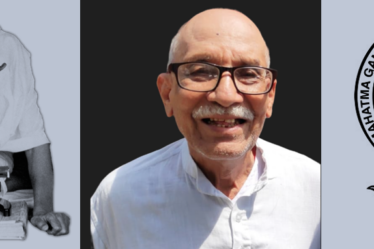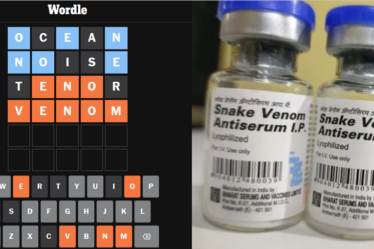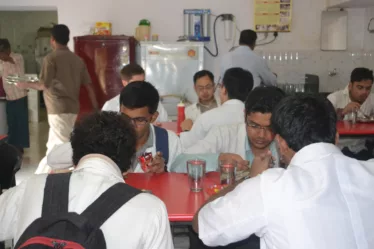In the scorching summer of 1975, my elder sister, then in her 30s, fell seriously ill. Dissatisfied with the medical care she was receiving in Bhopal, we quickly moved her to Wardha, where my parents lived.
Kasturba Hospital in Sevagram was still in its early stages back then. 𝗗𝗿. (𝗠𝘀) 𝗣. 𝗡𝗮𝘆𝗮𝗿, an Obstetrics and Gynaecology professor at MGIMS, became our beacon of hope. She diagnosed a severe post-operative infection, and admitted my sister to the hospital.
This wasn’t the modern hospital we know today. It was the building that now houses the community department, originally gifted by G.D. Birla to Mahatma Gandhi and later passed to Dr. Sushila Nayar. Its old walls, filled with countless stories, were where my sister found herself in a private room.
She remained in the hospital for a month, receiving intravenous penicillin—then the most potent antibiotic for sepsis—along with “saline and glucose”, painkillers, and vitamins for her infection. Dr. P. Nayar visited her twice a day. She spoke in her deep voice, reassuring her with, “This too shall pass.” Her calmness, confidence, and comforting words eased my sister’s pain and helped her endure the fevers.
In 1975, I was a medical student at GMC Nagpur. Fresh from passing my first MBBS exams, I headed home for summer break. I took it upon myself to care for my sister, bringing her meals and keeping her company throughout the night in her private room. Having just mastered riding a two-wheeler, I eagerly anticipated riding from Wardha to Sevagram on the new Vespa my father bought, regardless of the time of day.
As dusk fell over Sevagram, the hospital campus was eerily quiet, with few people around. There were no auto-rickshaws, only a handful of cycle rickshaws and a tonga. Cars were rare in Wardha, and the Sevagram square had just a Madras hotel and Babulalji’s tea shop.
I spent my entire summer break there, keeping to myself, quiet and shy. Despite passing by MGIMS medical students every day, I never exchanged a word with them. Little did they know, I was also a medical student from a nearby college. It’s amusing how, a few years later, I found myself working alongside those very students as a senior resident in medicine during the summer of 1982.
I never imagined I’d spend my entire 43-year professional career in Sevagram. It seems destiny had plans for me all along.
Back then, there were no modern equipment, operating rooms, ICUs, advanced diagnostic tests, or powerful drugs. What stayed with me, then and now, was the care provided to my sister by the nurses, many of whom were from Kerala. Dr. P. Nayar affectionately called my sister “Gudia”—she was small and thin—even though she was a mother of three. The Kerala nurses also used this endearing name. They brushed her hair, bathed her daily, and hand-fed her. Their soft words encouraged her to relax and aided in her recovery.
I can’t recall the names of the Ob Gyn doctors and nurses at that time. But I found out from the 1975 MGIMS annual report that 𝗗𝗿. (𝗠𝘀) 𝗔𝗿𝗰𝗵𝗮𝗻𝗮 𝗔𝗰𝗵𝗮𝗿𝘆𝗮 and 𝗗𝗿. (𝗠𝘀) 𝗖𝗵𝗲𝗹𝗹𝗮 𝗛𝗮𝗿𝗶𝗵𝗮𝗿𝗮𝗻 were part of the faculty. Were my sister admitted a month later, she might have seen 𝗗𝗿. (𝗠𝘀) 𝗦𝗵𝗮𝗸𝘂𝗻𝘁𝗮𝗹𝗮 𝗖𝗵𝗵𝗮𝗯𝗿𝗮, who started her MGIMS tenure in July 1975. I never spoke to the Obstetrics and Gynecology faculty. I simply nodded when they entered the room, feeling awestruck in their presence.
A month later, my sister was well enough to be discharged from the hospital. My other sister and I went to settle her bill. To our surprise, the cashier was located right by the hospital door, where a security guard from the “54” now stands. We couldn’t believe our eyes—or ears—when we heard the total: just Rs 610 for a month’s stay in a private room, including two weeks of round-the-clock penicillin, IV fluids, blood tests, x-rays and daily dressings.
We paid the bill in cash—using Rs 100, 50, 10, 5, 2, and 1 rupee notes, along with fifty paise coins. Back then, there were no UPI, debit, or credit cards. And I wasn’t old enough to write a cheque.
My sister, who is now in her early 80s and still lives in Bhopal, remembers those days clearly. Even though fifty years have passed since her admission to Kasturba Hospital and twenty-seven years since Dr. P. Nayar’s passing, my sister still cherishes her memory, as well as those of the compassionate Kerala nurses who cared for her.
Those days were truly special. Hospitals were havens of healing, where patients could rely on their caregivers. Everyone felt love and kindness all around, and and worrying about money didn’t often get in the way of getting better.



Read ur write up and perceived its contents. Your write up was with usual flair that is so very ur USP. But its a poignant reminder of the golden days gone by were students with empathy used to seek this noble profession. So with bare minimum tools pts were treated with a fair outcome. But now it has degraded to abysmal levels of a business endeavor where return of interest is calculated from the first day of ur practice. I feel suffocated in today’s medical field. Not all is lost but much has been lost never to be regained. I have tried my best to be as honest, principally oriented as I would have liked to be. Thanks for all the qualities that u as our teachers have imbibed in us. Indebted to you all.Pranam sir 🙏
Pranam to Dr P Nayyar, Dr Acharya, Madam Dr Hariharan, Madam Dr Chhabra, Madam. Dr Trivedi, Madam Dr Samal, and Madam Dr Rani Bang. I did my House jobs and then did PG from GMC Nagpur. Devotion of all faculty teachers and love for students is the real success of MGIMS. Dr SP Kalantri Sir and his friend Dr Baheti I know from college days. They were both hardworking and very intelligent. Medicine Department was proud of both at GMC Nagpur. Guru Bhramha Guru Vishnu Guru Devom…..
Great memories, Sir ! 👍👍🙏👍👍
Nice write-up. That’s what we tried to learn about patient management from the most experienced individuals, who also had a Gandhian background and who had come in contact with Vinoba Jee. He always said, “With any ‘pathy’ (Allopathy, Homeopathy, or Ayurveda), if there is no SYMPATHY, the patient never feels satisfied, relieved, or happy. Treatment is never with drugs alone. What helps relieve the patient is the doctor’s politeness, compassion, and assurance.” These are the same qualities that students—the future doctors—could adopt and have been successful in their practice, wherever they are.
Wonderful narration of a an era, which the coming generations will know through these stories 👌🏼
Sewagram is the same today dedication n love for healing is in everyone whose associated with MGIMS
❤️🙏,Great Narration !
Thank you for sharing a nice article.
Oh, what an unfeigned and heartfelt time that was! What a wonderful story, Mama. I was unaware of many details myself. And that ‘Gudia’—a mother of four—while I was just a four-year-old child.
I shared this entire narrative with my mother, and she was moved to tears. The doctors of Sevagram have always been known for their kindness, both then and now.Bhopal still struggles with inadequate medical facilities
1975 was a golden year in many ways. My father and our family moved to Sewagram from New Delhi. I joined KVM, and we used to live in Ramakrishna Colony—an area with old-style row houses. It was very quaint. I understand when you say it was eerie in the evenings. 😅
Your writing is detailed, simple, and engrossing! Please excuse my limited vocabulary; it hardly does justice to your excellent work. 🙏 If possible, I would love to meet you personally someday. I know that even a few meetings wouldn’t be enough to fully understand your way of thinking, but I believe I would still feel content.
All movements scrolling in front of my eyes.Thanks for your write-ups. It’s looks like “memory re call”👌👍🙏
The entire episode of 1975 was seemingly nostalgic. The care, the love, the faith, and the dedication of the team at Kasturba Hospital made it feel like family time when we visited my mother. There was a deep sense of belonging and sincere advice, which we still lack today despite the many facilities and new medical services available in this era. It was a near comeback from the heart-wrenching revelation of a post-operative severe infection from medical services in Bhopal. At Sevagram, with the doctors of Kasturba Hospital, it felt like being with family. I still remember the lovely ambiance and learned how to care for a patient, even as a middle school girl. Mama says correctly that those were times when hospitals were havens of healing. We still have a dear Sister of Dr. S. P. Kalantri. All due respect to the world’s best Sevagram. May it carry on the legacy of unconditional services forever.
This is a very personal and emotional memoir. I can visualize a shy and humble young medical student in attendance, helping a sick sister. This was probably the first instance when you imbibed the ethos of Sevagram. The rest, as they say, is history. Your chronicles are worth their weight in gold. You have not only imbibed and propagated the true spirit of MGIMS but also documented it for posterity. I joined MGIMS in 1976, little knowing the impact it would have on me. I did my MD from GMC Nagpur, so we share the same alma mater, though I was fortunate to have first been exposed to MGIMS. You are very fortunate to have served MGIMS for the past 43 years. You are more of an MGIMSian than us. Great!